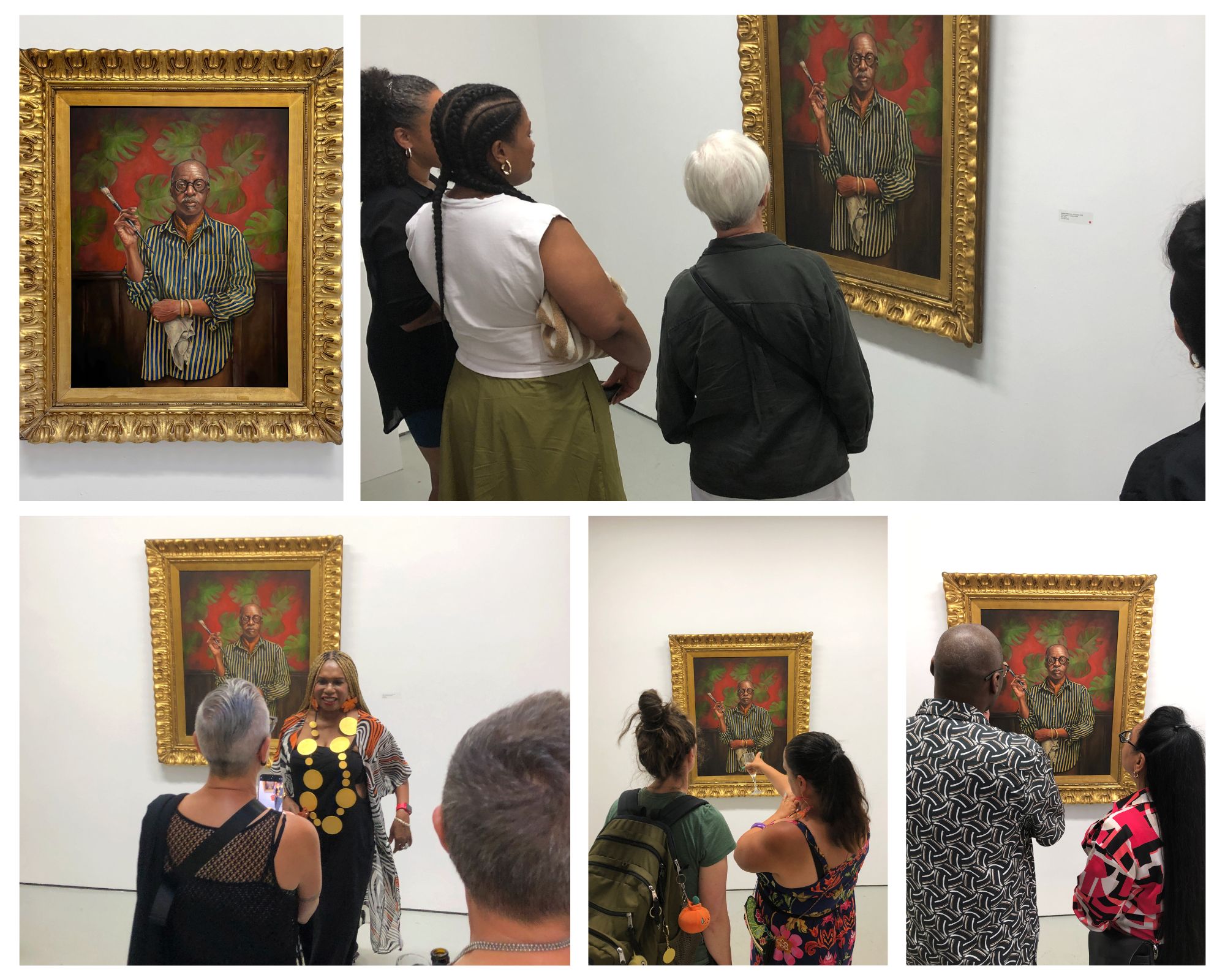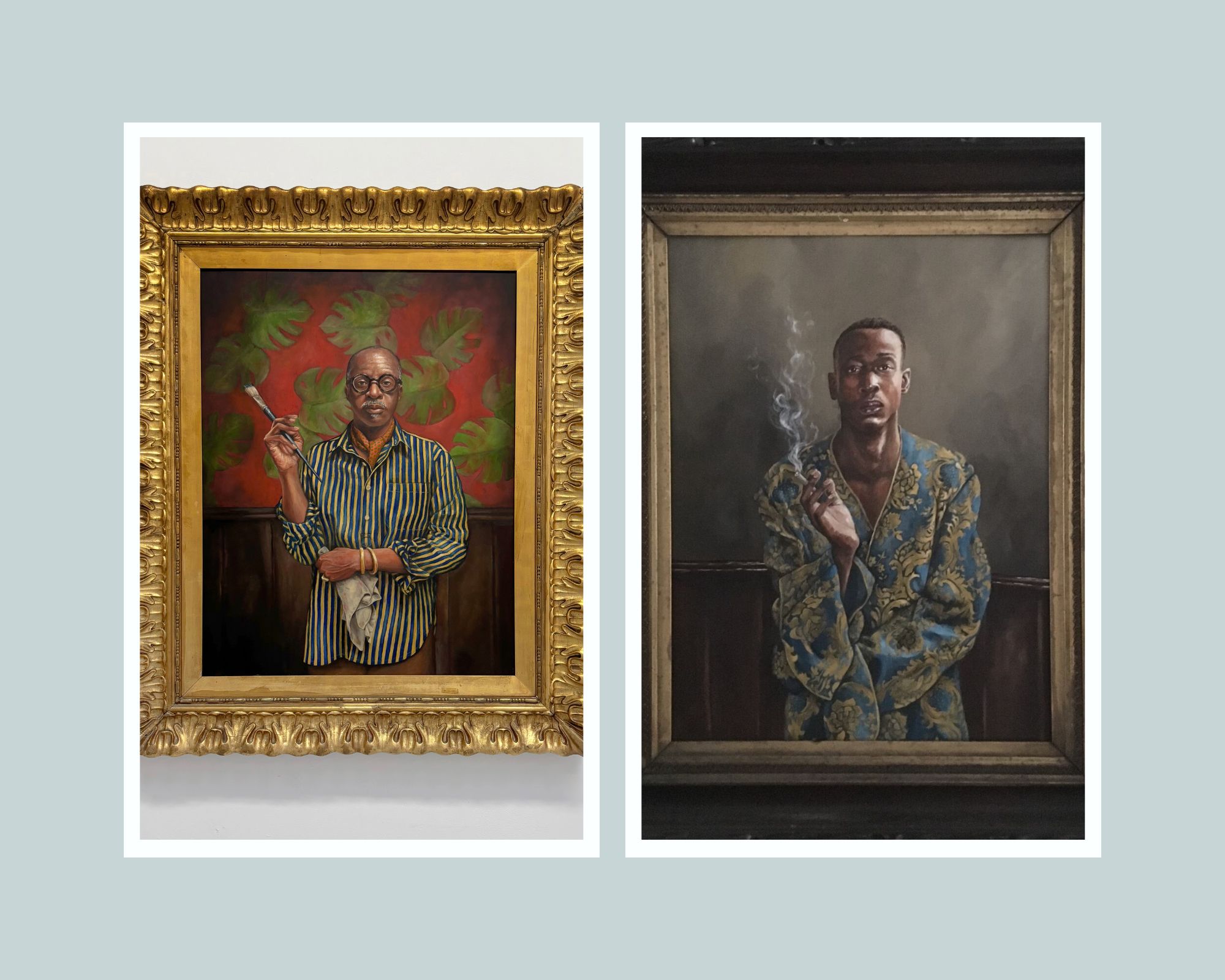Whitehot Magazine
November 2025
"The Best Art In The World"
"The Best Art In The World"
November 2025
Too Much Fashion: Gordon Shadrach on Fashion, Identity, and Style as Survival
 Too Much Fashion Exhibiting Artists (L to R): Veronica Dorsett, "6ix-Love" (2025), Kachelle Knowles, "Don't Get Off Your Strawberry Swing" (2025), Janice Reid, "Strictly Roots" (2025), Kriss Munsya, "Even, Genetic Bomb" (2025), Ojo Agi, "Untitled (Bun)" (2025), Benny Bing "SLICK" (2024), Adetona Omokanye "Untitled 5 (Spiritually Fashionable)" (2021), Ehiko Odeh "Cultural Sanctuary, Untiled 5" (2025). Gordon Shadrach's "Resolution" (2025) pictured in article below.
Too Much Fashion Exhibiting Artists (L to R): Veronica Dorsett, "6ix-Love" (2025), Kachelle Knowles, "Don't Get Off Your Strawberry Swing" (2025), Janice Reid, "Strictly Roots" (2025), Kriss Munsya, "Even, Genetic Bomb" (2025), Ojo Agi, "Untitled (Bun)" (2025), Benny Bing "SLICK" (2024), Adetona Omokanye "Untitled 5 (Spiritually Fashionable)" (2021), Ehiko Odeh "Cultural Sanctuary, Untiled 5" (2025). Gordon Shadrach's "Resolution" (2025) pictured in article below.
By BYRON ARMSTRONG August 26, 2025
"Too Much Fashion: An Ode to Black Creative Resilience" channels late icon André Leon Talley’s pop culture mantra — captured for posterity in the future equivalent of ancient hieroglyphics, the internet meme — into a visual celebration of sartorial defiance. Running from August 1st, 2025 until August 30th at United Contemporary, located on a lush side street just south of the arty, hip Queen West neighbourhood, the multidisciplinary group show spotlights nine artists: Ojo Agi, Benny Bing, Veronica Dorsett, Kachelle Knowles, Kriss Munsya, Ehiko Odeh, Adetona Omokanye, Janice Reid and Gordon Shadrach. Curated by Armova Curatorial — a team consisting of Byron Armstrong (me) and artist/educator/curator Ilene Sova — the group show reframes Black sartorial expression as a radical act of cultural preservation, while placing a spotlight on the intersection of historical Black dandyism and contemporary aesthetics. From the sharp lines of Jamaican Dancehall attire to the cultural flamboyance of Yoruban spiritual ceremonies, the exhibition dissects how Black communities globally have transformed clothing into a tool of resistance, dignity, and joy for Black communities, while managing to influence style through their unshakeable resilience.
Among its featured artists is Gordon Shadrach, a Toronto-based painter whose work is steeped in personal narrative and Black historical reclamation. I’ve spoken to him before, alongside group show participant Kachelle Knowles, a duo who have shown together previously in the transatlantic exhibition “When the Bread They Have Cast on the Waters Comes Floating Back.” Coincidentally, you can find that discussion in Whitehot Magazine’s 20 year compilation of art coverage and critique The Best Art in the World. In this show, Shadrach offers a poignant counterpoint to erasure, transforming brocade, cravats, and tailored silhouettes into visual manifestos. In this candid Q&A, he traces his lifelong dance with fabric, respectability politics, and why inserting himself into the canvas marks a deeply personal evolution that was decades in the making.
 Opening night visitors viewing Gordon Shadrach's "Resolution" at Untied Contemporary.
Opening night visitors viewing Gordon Shadrach's "Resolution" at Untied Contemporary.
Your work in "Too Much Fashion" engages deeply with Black dandyism. How did your upbringing shape your relationship with style?
Gordon Shadrach: Fashion was embedded in my DNA. My grandmother was a seamstress, and my mother treated dressing as ceremony — every detail mattered. But it wasn’t just aesthetics; it was survival. I always used to admire the care that my mother would take when she'd get dressed. I think part of it for my parents too, was related to growing up in a certain era.
There was that concept of appearance and being dignified. But it wasn’t dignity, it was a form of respectability politics, where in order to show your value and your place in society, you had to present yourself a certain way. That idea of being constantly judged really stuck with me. I had to keep my school clothes nice and clean. If I played in the mud like the other kids, the judgment would be harsher. My parents nurtured my interest in fashion, though. When I showed up to high school in the ’80s as the first Black kid with a Grace Jones flat-top and got mocked, the next year, everyone showed up with one. So my parents really understood the importance of expressing myself through fashion and really encouraged me. So when I got older and I started making my own money, I started buying and then making my own clothes. I really enjoyed that creative process of looking at something and trying to figure out how I could make it, and that just went on pretty much through most of my like young adulthood.
 Too Much Fashion vernissage (L to R): Artists Kachelle Knowles posing in front of her work / A viewer taking in Benny Bing's portrait / Artist Janice Reid in conversation with collector and Wedge Curatorial Founder/director Dr. Kenneth Montague / Viewers taking in the work of Ojo Agi / Visitors discussing Gordon Shadrach's "Resolution" / Photographer Adetona Omokanye in conversation with visitors / opening night crowds.
Too Much Fashion vernissage (L to R): Artists Kachelle Knowles posing in front of her work / A viewer taking in Benny Bing's portrait / Artist Janice Reid in conversation with collector and Wedge Curatorial Founder/director Dr. Kenneth Montague / Viewers taking in the work of Ojo Agi / Visitors discussing Gordon Shadrach's "Resolution" / Photographer Adetona Omokanye in conversation with visitors / opening night crowds.
The exhibition frames fashion as cultural resilience. What resonated with you about this theme?
Gordon Shadrach: So my degree is actually in textile. When I wanted to study art, I never studied painting and drawing as a focus. I didn't really see how I would support myself as an artist, and I didn't really see black artists, period. I thought it was something for tortured white kids who had the support of their families. So I didn’t perceive it as something I thought I could do. I thought if I studied something, it should connect to an interest like fashion. I had a goal of becoming a fashion illustrator. In a way, I sort of became a fashion illustrator, because I brought my interest in fashion into my artwork, which feels like validation. I was really happy to be part of this, because this is something that has been so integral in my development as an artist. I’ve painted Black figures in historical dress to reclaim narratives erased from art history. This show elevates that conversation — it’s not just about clothes but about how we’ve used style to assert our humanity. Seeing Black creativity centered like this? It’s powerful. Fashion has always been integral to my art; it’s one way I contribute to the culture. Fashion isn’t just self-expression — it’s a language of resilience.
Working in a group show versus working in a solo show, do you feel like there's a little less pressure on you than you would usually experience?
Gordon Shadrach: [Laughs] No — I’m my own worst critic. Whether it’s one piece or twenty, I won’t show anything I’m not 100% proud of. I don't think anyone's ever completely convinced that their work is finished or perfect, and I don't strive for perfection, but I want my work to be in a position that I feel comfortable presenting it. So there's always pressure on me. My partner says I put too much pressure on myself, but it’s because I want the work to honor its subjects.
 Gordon Shadrach, "Resolution" (2025) / Gordon Shadrach, "Patience" (2017). Oil on panel in antique frames.
Gordon Shadrach, "Resolution" (2025) / Gordon Shadrach, "Patience" (2017). Oil on panel in antique frames.
Your contribution is a self-portrait that revisits an older piece. You don’t usually centre yourself in your paintings, so why now?
Gordon Shadrach: After my last show, an interviewer asked me why I used "avatars" instead of painting myself. It stuck with me. For "Too Much Fashion," I revisited “Patience” (2017) — a pivotal early work where I first poured my love of textiles into a portrait of a young man wearing a robe with a brocade pattern. Anyone who knows me knows how much I'm interested in fashion, and how much I really love exploring the impact that fashion has had on black culture. The painting I’ve done for the show is a way of inserting myself into this dialogue that I've been having with people for so long.
I wanted to revisit “Patience” and recreate that in a way that is representative of me. As much as I love the idea of being the Dandy, I also wanted to keep it at a level that was believable. I'm standing in the same position as the original model, but not in a big brocade robe smoking while holding a cigarette. This new version places me in that young man’s position, but in my studio, wearing a cravat and striped shirt, while holding a paint brush rather than a cigarette. It shows that style is an important part of who I am and who I've always been, but that I’m also an artist and designer of my own look, as well as the other looks I've been putting into my paintings. It’s my way of stepping into the dialogue I’ve curated for others as the artist, the subject, and the dandy — owning all parts of my story.
Style is not necessarily what you wear. It's how you wear it.
Gordon Shadrach: Exactly. There’s a big focus on social media around showing people the difference between wearing clothes and being styled in clothes, which could be as simple as tucking in or untucking a shirt. To me, style isn’t just what you wear; it’s how you declare who you are.
Too Much Fashion: An Ode to Black Creative Resilience
United Contemporary 129 Tecumseth Street, Toronto, Canada
August 1st to August 30th

Byron Armstrong
Byron Armstrong is an award-winning freelance journalist and writer who investigates the intersections between arts and culture, lifestyle, and politics. Find him on Instagram @thebyproduct and on Linkedin https://www.linkedin.com/in/byron-armstrong
view all articles from this author








